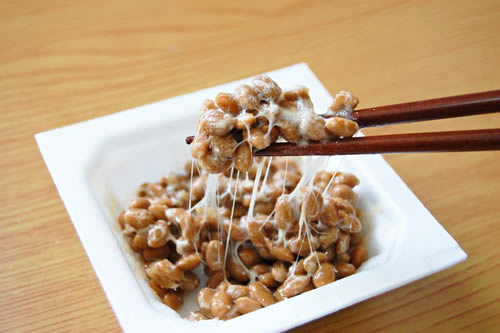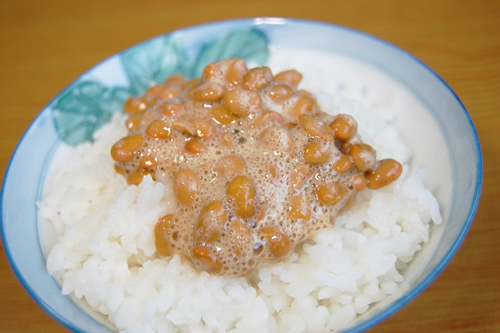Posted by TOKYO MATCHA SELECTION on 1st Apr 2017
Natto, Healthy Fermented Soybeans

Allow me to introduce you to this delicious and nutritious food from Japan.
Natto is the Japanese word for fermented soybeans; it's brown and slimy, and has a distinctly strong smell like good cheese. The smell can be intense and and intimidating though the taste is more bland than you would think. I have heard people describe the it as "bland, slimy, stinky beans". Though the taste is subtle I wouldn't eat it without adding soy sauce.
Natto is a typical breakfast food found in most households. If you stay in a Japanese hotel you will most likely be offered natto upon waking along with miso soup, seaweed, pickles, rice, fish, and maybe some eggs.
Natto is truly such a gem; nutritious, delicious, and easy to make. I want to help familiarize you with natto; how to eat it; it's health benefits; and it's history. If you try it at least once, not forgetting the soy sauce, you might just love it.
Your health is perhaps the biggest important factor in life, therefore unusual health foods such as this one are highly recommended. At the very least, it can be very entertaining to make this bizarre slimy fermented soybeans, and dare your dear family members and friends to try it!
Health benefits of Natto
Natto contains iron, calcium, magnesium, protein, potassium, vitamins B2, B6, E, K2, and more! It has been used traditionally as a blood thinner and bone fortifier. Recently scientists have extracted the nattokinase enzyme that is used as a health supplement and a blood thinning agent. After doing some research, I now view natto as a great food to keep the heart strong and the blood flowing well.
History of Natto
There are many differing stories of how natto came to be. The one I like is about a poor farmer who was preparing gifts of his abundant harvest for his feudal lord, as was the requirement. He had decided to offer boiled soybeans so he wrapped them up in straw, packed them well on his horse, and headed for the castle. Rains started to pour and he was forced to postpone further travels, taking shelter under a large tree. By the time the farmer arrived at the lord's castle, the naturally occurring beneficial bacteria,Bacillus Subtilis, had overtaken the beans. When the lord unwrapped the package and the farmer saw the slimy sticky brown mess inside, he felt certain that his life had come to a close. Luckily, the lord tried it, liked it, and even praised the farmer for this new delicacy! Hooray!
How to Make Your Very Own Natto
As you would have guessed from the story of the lucky farmer, it is extremely easy to make your own natto. If you live in a place with access to natto, perhaps at an asian grocer, you can keep propagating the Bacillus Subtilis as much as you desire.
-Soak a half cup of soybeans in 3 cups of water overnight
(The beans get huge, so be sure to put them in a big mixing bowl!)
-Steam or boil beans till soft
(Steamed soybeans have a better texture, but boiled works too!)
-Add the natto pack, and mix well
(Bacillus Subtilis can survive boiling temperatures!)
-Place in thermos overnight
(Be sure to disinfect the thermos with boiling water first!)
Tadaaa! You've propagated your very own natto!
If you live somewhere far from an asian grocer, don't fret, as natto can be made with a surprisingly wide number of dried grasses. These wild grasses naturally host the Bacillus Subtilis, which is the bacteria that will convert cooked soybeans into natto, to produce such a nutritious and delicious food. Just find a field full of dried grass and grab a handful of the stems. Boil the grass for a good twenty minutes to kill off any potential competition to the Bacillus Subtilis. You can strain and boil again to make sure the bitter taste of the grass doesn't negatively affect your natto eating experience. Remember that Bacillus Subtilis can withstand boiling temperatures so don't worry about boiling the grass. After that the steps are just as above, substituting the packaged natto for the handful of boiled grass.
How to Eat Natto

Many people will eat their pack of natto on warm white rice, adding some soy sauce and a dab of mustard. My preference is to have about a small cup full of natto (about 60g) on some warm sprouted brown rice, mixed with one raw egg, and some Korean style kimchi. The interesting part of this is using nori seaweed sheets to wrap each bite. You can use your hand to tear the nori seaweed sheets into cell phone sizes. I use a nori wrap for every bite I take, so I end up using about 10 of those full sized sheets. Please note: most people don't use as much nori seaweed. Please also note: my hair grows ridiculously fast, due, I believe, to the massive amounts of seaweed that I love to ingest. (It has been 3 years since I shaved my hair off like a nun, and it has already grown to below my shoulder blades.)
Anyhow, if using chopsticks are a little tricky for you, you can do this next step with your fingers. It's totally okay! Place a seaweed sheet on the rice, and use your chopsticks (or fingers) to wrap and pick up a good bite. Natto is extremely slimy, so be sure to bring the rice bowl close up to your mouth. Seriously, this can get messy! A great activity with friends perhaps?
Cleaning Up
Another magical aspect of natto is the slime. I am still astounded by it every time I clean my bowl afterwards. Although it is so extremely slimy and sticky, soap is not needed to remove the slime you can rinse if off with just water to get the dish squeaky clean. It's worth it to try it once to experience this interesting phenomena!